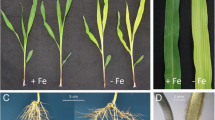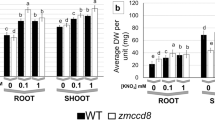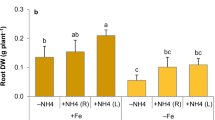Abstract
Maize plants follow Strategy II to take up Fe from the rhizosphere. In roots, nicotianamine is used as precursor for the production of deoxymugineic acid (DMA). DMA is secreted to the rhizosphere where it chelates Fe(III) and the Fe(III)-DMA complex is then taken up by the root. In this study, non-mycorrhizal and mycorrhizal maize plants were grown in pots with sterile river sand containing FePO4. After a 60-day period of sulfur deficiency, sulfur was provided to the plants in the form of sulfate. The expression profiles of ZmNAS1, ZmDMAS1, ZmTOM1 and ZmYS1, key genes of the Fe uptake pathway in maize, were monitored 24 and 48 h after sulfate addition in both mycorrhizal and non-mycorrhizal roots in order to estimate the impact of sulfate availability on the Fe uptake pathway of two distinct plant systems. Significant differential responses have been recorded between mycorrhizal and non-mycorrhizal plants, both before as well as 48 h after sulfate addition. However, sulfur repletion resulted in a significant downregulation of all studied genes in all plants 24 h after sulfate addition. This finding suggests a strong correlation between the transcriptional regulation of the Fe uptake pathway genes and sulfate availability no matter if the plants are in mycorrhizal association or not. Sulfate is probably a key component of the signal transduction pathway that regulates the expression of the Fe uptake pathway genes in maize plants.
Access provided by CONRICYT-eBooks. Download conference paper PDF
Similar content being viewed by others
Keywords
These keywords were added by machine and not by the authors. This process is experimental and the keywords may be updated as the learning algorithm improves.
Iron (Fe) is an essential nutrient for all living organisms. In plants, Fe plays a key role in electron transfer in both photosynthetic and respiratory reactions in chloroplasts and mitochondria. In soils, Fe is sparingly soluble under aerobic conditions at high soil pH and exists mainly in its oxidized form, as part of insoluble ferric compounds. In addition to the solubility challenge, the chemical properties of iron require cells to place limitations on its accumulation. Fe(II) and Fe(III) act catalytically to generate hydroxyl radicals that can damage cellular constituents such as DNA and lipids (Halliwell and Gutteridge 1992). Higher plants employ two strategies for Fe uptake from their rhizosphere. Dicots and non-grass monocots take up Fe using ferric-chelate reductases to reduce Fe(III) to Fe(II), which is subsequently taken up by Fe transporters (Connolly et al. 2003). This type of Fe uptake is known as Strategy I pathway for Fe acquisition. Alternatively, graminaceous plants take up iron from their rhizospheres using the Strategy II pathway for Fe acquisition. In this pathway, S-adenosyl-methionine (SAM), a sulfur-containing compound, is used for the production of nicotianamine (NA) by the enzyme family of nicotianamine synthases (NAS). NA is then used as precursor for the biosynthesis of deoxymugineic acid (DMA), the first phytosiderophore produced in graminaceous plants and the only one produced in maize. The biosynthesis is conducted in a two-step process by the enzymes of nicotianamine amino-transferase (NAAT) and DMA synthase (DMAS). In maize, the efflux transporter TOM is used for the excretion of the produced DMA to the rhizosphere, where it chelates Fe(III). The complex DMA-Fe(III) is, finally, taken up by the root via a yellow stripe transporter (YS; Nozoye et al. 2013).
Over recent years, sulfur deficiency has become widespread in the world, mainly because of the strong decrease in the inputs of S from atmospheric deposition and the use of S-free fertilizer products such as triple phosphate and urea. Although it is often reported that cereals have a relatively low requirement for S, they can be adversely affected by S deficiency in the field as a result of its effects on growth, grain yield, and quality (Zhao et al. 1999). In plants, cysteine represents the main source of reduced S and is fundamental for the biosynthesis of methionine, Fe–S clusters and glutathione. Thus, there is a strong relationship between S and Fe homeostasis and the role of S in the Fe uptake pathway of graminaceous plants is crucial. It has been demonstrated that sulfur deficiency causes Fe deprivation responses to graminaceous plants which can be reversed, however, by sulfur repletion (Astolfi et al. 2003, 2006, 2010; Bouranis et al. 2003).
In this study, non-mycorrhizal and mycorrhizal maize plants were grown in pots with sterile river sand, in a long-term experiment (Fig. 1). For the mycorrhizal treatment, inoculum of the arbuscular mycorrhizal fungus Rhizophagus irregularis was used. Plants were watered with a nutrient solution deprived of Fe and S and containing a minimum P concentration so as to enhance the establishment of the arbuscular mycorrhiza (AM) symbiosis. Iron was provided throughout the experiment in the sparingly soluble form of FePO4. After a 60-day period of sulfur deficiency, sulfur was provided to the plants in the form of sulfate, as described previously (Chorianopoulou et al. 2015). In order to estimate the impact of sulfate availability on the Fe uptake pathway, the expression profiles of ZmNAS1, ZmDMAS1, ZmTOM1 and ZmYS1, key genes of the Fe acquisition pathway in maize (Fig. 2a), were monitored 24 and 48 h after sulfate addition in mycorrhizal and non-mycorrhizal roots. The gene expression analysis was conducted by means of Real-Time RT-PCR. The oligonucleotide primers used for RT-qPCR are listed in Table 1. The efficiency of each Real-Time RT-PCR reaction was calculated using the LinRegPCR software (Ruijter et al. 2009). The mathematical formula of Pfaffl (2001) was used for the calculations of the relative expression ratios and ubiquitin was used as reference gene. The results of each sampling were expressed with the use of the previous sampling as control in order to determine the shift in the expression after sulfate supply.
Depiction of the experimental design of this study. Mycorrhizal and non-mycorrhizal plants were grown under S deficient conditions until day 60 from sowing; all plants were watered with a nutrient solution deprived of Fe and S and containing 10 μM of P (Pmin) to trigger the establishment of the mycorrhizal symbiosis. On day 60, sulfate was provided to the plants. Fe was available throughout the experiment in the form of sparingly soluble FePO4. Samplings took place on day 60 (before S repletion) as well as on days 61 and 62, 24 and 48 h after sulfate addition, respectively
(a) Schematic illustration of the Strategy II Fe uptake pathway in maize roots. (b) Expression shift patterns of ZmNAS1, ZmDMAS1, ZmTOM1 and ZmYS1, 24 and 48 h after sulfate addition in mycorrhizal (M) and non-mycorrhizal (NM) maize roots. The expression shift values were calculated, each time, relatively to the previous sampling, revealing the pattern of the expression change the first 24 and 48 h after S supply. Arrows pointing up or down represent increase or decrease, respectively, in the expressions of the genes
It has been recently shown that S deprived mycorrhizal maize roots suppressed the expression of two key genes of the Fe uptake pathway, ZmNAS1 and ZmYS1, in contrast to non-mycorrhizal ones which enhanced it. In addition, AM symbiosis prevented Fe deprivation responses in the S deprived maize plants suggesting that iron was possibly provided directly to the mycorrhizal plants through the fungal network (Chorianopoulou et al. 2015). Differential response of the four key genes of the Fe uptake pathway in maize was observed between mycorrhizal and non-mycorrhizal roots 48 h after sulfate addition (Fig. 2b, Table 2). Non-mycorrhizal roots upregulated all the respective genes while mycorrhizal roots downregulated only the transporters ZmTOM1 and ZmYS1 whilst the relative expression ratios of ZmNAS1 and ZmDMAS1 did not alter significantly. These findings revealed that the two systems, mycorrhizal and non-mycorrhizal, respond differently as far as the Fe acquisition pathway is concerned.
Interestingly, despite the observed differential responses between mycorrhizal and non-mycorrhizal plants, a common response of all plants was revealed 24 h after sulfate addition, i.e. an identical decreasing pattern in the expressions of all genes of the Fe uptake pathway. This expression pattern was irrelevant of the symbiotic phenomenon and the short-term common response was related to the sulfate supply itself (Fig. 2b, Table 2).
Thus, our observations suggest a strong relationship between resupply of sulfate and the transcriptional regulation of the Fe uptake pathway genes in S-deprived maize plants, regardless of whether these plants are in mycorrhizal association, or not. This evokes the assumption that sulfate itself is a negative regulator of the Strategy II Fe acquisition pathway and the reduced S compounds (i.e. cysteine, methionine) are catalytically important to trigger the production and secretion of DMA.
Given the fact that most of the metabolically active Fe is bound to S in Fe–S clusters, the interaction between Fe and S homeostasis is of particular importance (Forieri et al. 2013). The biosynthesis of Fe–S clusters requires the supply of reduced S (in form of cysteine) and chelated Fe in a defined stoichiometric ratio, strongly suggesting the development of cross-regulatory mechanisms between the metabolisms of the two nutrients. In this line, the provision of the substrates must be tightly regulated in order to meet the plant’s changing demands for Fe–S clusters and to avoid potentially toxic free Fe and sulfide.
In conclusion, our work underlines the importance of sulfate as signaling molecule that regulates the Strategy II Fe acquisition pathway; such a role of sulfate has been previously proposed by Forieri et al. (2013) for Fe homeostasis. In addition, we highlight the significance of sulfate reduction for the enhancement of Fe uptake and provide indications that when sulfate is abundant, the Fe uptake pathway is suppressed.
References
Astolfi S, Zuchi S, Passera C, Cesco S (2003) Does the sulphur assimilation pathway play a role in the response to Fe deficiency in maize (Zea mays L.) plants? J Plant Nutr 26:2111–2121
Astolfi S, Cesco S, Zuchi S, Neumann G, Roemheld V (2006) Sulphur starvation reduces phytosiderophores release by Fe-deficient barley plants. Soil Sci Plant Nutr 52:80–85
Astolfi S, Zuchi S, Hubberten H-M, Pinton R, Hoefgen R (2010) Supply of sulphur to S deficient young barley seedlings restores their capability to cope with iron shortage. J Exp Bot 61:99–806
Bouranis DL, Chorianopoulou SN, Protonotarios VE, Siyannis VF, Hopkins L, Hawkesford MJ (2003) Leaf response of young iron-inefficient maize plants to sulfur deprivation. J Plant Nutr 26:1189–1202
Chorianopoulou SN, Saridis YI, Dimou M, Katinakis P, Bouranis DL (2015) Arbuscular mycorrhizal symbiosis alters the expression patterns of three key iron homeostasis genes, ZmNAS1, ZmNAS3, and ZmYS1, in S-deprived maize plants. Front Plant Sci 6:257
Connolly EL, Campbell NH, Grotz N, Prichard CL, Guerino ML (2003) Overexpression of the FRO2 ferric chelate reductase confers tolerance to growth on low iron and uncovers posttranscriptional control. Plant Physiol 133:1102–1110
Forieri I, Wirtz M, Hell R (2013) Toward new perspectives on the interaction of iron and sulfur metabolism in plants. Front Plant Sci 4:357
Halliwell B, Gutteridge JMC (1992) Biologically relevant metal ion dependent hydroxyl radical generation. FEBS Lett 307:108–112
Nozoye T, Nakanishi H, Nishizawa NK (2013) Characterizing crucial components of iron homeostasis in the maize mutants ys1 and ys3. PLoS One 8:e62567
Pfaffl MW (2001) A new mathematical model for relative quantification in real-time RT-PCR. Nucleic Acids Res 29:2002–2007
Ruijter JM, Ramakers C, Hoogaars WM, Karlen Y, Bakker O, van den Hoff MJ, Moorman AF (2009) Amplification efficiency: linking baseline and bias in the analysis of quantitative PCR data. Nucleic Acids Res 37:45
Zhao FJ, Hawkesford MJ, McGrath SP (1999) Sulphur assimilation and effects on yield and quality of wheat. J Cereal Sci 30:1–17
Author information
Authors and Affiliations
Corresponding author
Editor information
Editors and Affiliations
Rights and permissions
Copyright information
© 2017 Springer International Publishing AG
About this paper
Cite this paper
Saridis, G.I., Chorianopoulou, S.N., Katinakis, P., Bouranis, D.L. (2017). Evidence for Regulation of the Iron Uptake Pathway by Sulfate Supply in S-Deprived Maize Plants. In: De Kok, L., Hawkesford, M., Haneklaus, S., Schnug, E. (eds) Sulfur Metabolism in Higher Plants - Fundamental, Environmental and Agricultural Aspects. Proceedings of the International Plant Sulfur Workshop. Springer, Cham. https://doi.org/10.1007/978-3-319-56526-2_17
Download citation
DOI: https://doi.org/10.1007/978-3-319-56526-2_17
Published:
Publisher Name: Springer, Cham
Print ISBN: 978-3-319-56525-5
Online ISBN: 978-3-319-56526-2
eBook Packages: Biomedical and Life SciencesBiomedical and Life Sciences (R0)






